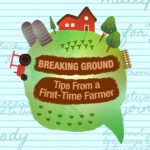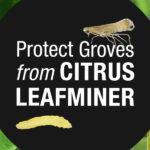What Pesticide Is in Your Jug?
Growers need to evaluate product performance when selecting crop inputs.

Is your farming operation more complex today than it was 10 years ago? Is it important that you stay on the leading edge of innovation to stay competitive?
“If you answered yes to both questions, it’s crucial whom you hitch your wagon to, especially for profitable crop production,” says Mike Twining, vice president of sales and marketing with Willard Agri-Service of Frederick, Inc., which serves farmers in Delaware, Maryland, New Jersey, Pennsylvania, Virginia and West Virginia.
Twining knows farmers must keep an eye on their budgets but sees the bottom line as the key indicator. Realizing a strong bottom line, he says, requires evaluating which inputs deliver the most value.
“What growers are truly purchasing is a result,” Twining says. “That’s why I’m going to go with branded products.”
Duane McAllister, agronomy sales manager with Houff Corporation in Weyers Cave, Virginia, starts conversations by listening to farmers’ concerns about weed control and other challenges. He’s not annoyed when farmers who bought generic products complain that their herbicide container cracked and leaked. He takes it in stride when frustrated farmers demand to know how to get the last 20% out of a jug where the generic product has turned to sludge.
“In my early retail years, I might have gotten defensive in these situations,” McAllister says. “Now, I use this as a teaching tool to show why we recommend branded products.”
It starts with empathy. “I tell these farmers I understand their problem, because I’ve been in their shoes,” McAllister says. “I note that these are exactly the reasons why I choose Syngenta products, which are tested for specific formulations and consistent results.”
Consider the sludge in the jug, which can only be removed with elbow grease, McAllister adds. “I explain that if the Houff Corporation used generics like that, we’d never get to your field on time, because we’d be digging the product out of the jug, plus you wouldn’t get all the product you paid for. With branded products, you’re buying a solution you can count on.”
Keith Sheets gets it. “I don’t have time to learn everything about the chemistry of every product, so the Houff team is a valuable consultant for me,” says Sheets, who raises corn, soybeans and livestock near McGaheysville, Virginia.
With more than 35 years in business, Sheets still carefully analyzes spreadsheet data to determine return on investment. He values the Houff team’s expertise. “They aren’t going to sell me things I don’t need or that don’t work,” he says. “They also know my goals, with my No. 1 goal being making a profit.”
The farmer had used generic products to try to make his own Flexstar® GT 3.5 herbicide, but it crystallized. Just knowing the active ingredients isn’t enough to create a successful product.
Success Takes More Than Active Ingredients
Finding out what matters to farmers is a top goal for Syngenta. “We send our chemists into the field to find out what our customers’ crop protection needs are, compared with what we think they are,” says Matthew Cottle, Ph.D., group leader for herbicide formulation development at Syngenta.
When he was a formulation chemist, Cottle was concerned about bloom (particles dispersing in solution). “When I visited with a North Carolina farmer, he said he used an induction bowl that sucked everything in, so he wasn’t worried about bloom,” Cottle says. “Nothing beats directly interacting with clients. They’ll set you straight about what they like and what we can do better.”
Sometimes growers learn the hard way what “better” really means. Cottle thinks back to a retailer meeting in Rake, Iowa, that was interrupted by an angry farmer. “The farmer had used generic products to try to make his own Flexstar® GT 3.5 herbicide, but it crystallized. Just knowing the active ingredients isn’t enough to create a successful product.”
A Strong Formulation Maximizes Efficacy
Many factors go into producing high-quality crop protection products, including:
- Correct ratios of active ingredients and other key components. Roughly 10% to 50% of the components in a crop protection product are active ingredients. The remaining components include adjuvants and surfactants, which enhance spray coverage and stabilizers. Products that contain sugar-based stabilizers also contain preservatives, which inhibit bacterial growth and extend package shelf life.
- “That’s where the science comes in,” Cottle says. If the formula isn’t correct, for example, the product might thicken during cold springs, which are common in places like Wisconsin and Minnesota.
- “If the product is too thick, it slows down flow rates and can even burn out pump motors,” Cottle says. “Syngenta adds anti-freezing agents that enable liquid water-based formulations to endure natural freeze-thaw cycles without compromising product performance.”
- Physical stability of active ingredients. Hot weather creates its own challenges. “Heat can be detrimental to many active ingredients,” Cottle says. Generic mesotrione or S-metolachlor herbicides, for example, are known to have issues with stability. When hot weather hits, those products may not deliver the performance growers need in their fields.
- “We study active ingredients’ physical stability at various temperatures,” Cottle says. “Then we add the right stabilizers to ensure our products deliver consistent, robust results at different temperatures.”
Service After the Sale Drives Performance
None of this comes quickly or cheaply. The average time it takes to bring a new crop protection product to market can exceed 11 years and cost more than $265 million. Syngenta invests $1.3 billion in research and development each year, with 5,000 Syngenta scientists around the globe working on new and improved technologies.
McAllister finds field trials to be a particularly valuable test of the products, helping to ensure reliable results and crop safety. “When you explain to customers these differences between branded products and generic products, including service and support, the customers sell themselves on Syngenta products,” he says.
Service after the sale impresses Adam Dexter, a certified crop specialist with West Central FS in Williamsfield, Illinois. When some local growers had an issue with a corn herbicide last year, he recalls, “Syngenta had boots on the ground here within 24 hours.”
This support drives loyalty for West Central customer Grant Strom. “Price definitely factors into our choices, but service is important, too,” says Strom, who raises corn, soybeans, hay and beef cattle near Dahinda, Illinois. “I really like having the assurance of performance guarantees that come along with branded products versus generics.”
Strom continues to add more Syngenta products each year. In 2021, these include Bicep II Magnum® and Lexar® EZ corn herbicides, and Miravis® Neo fungicide on some corn and soybean acres. “Our salesman does an excellent job of supporting the products he sells,” Strom says. “He also deals with any issues of underperformance for us.”
Key for Willard Agri-Service is that the products they recommend deliver results for their customers. “As a retailer, we have to provide results,” Twining says. “We’ve vetted Syngenta products against the competition, and we know they’ll work consistently for our customers. We win when our customers win.”
4 Min Read























